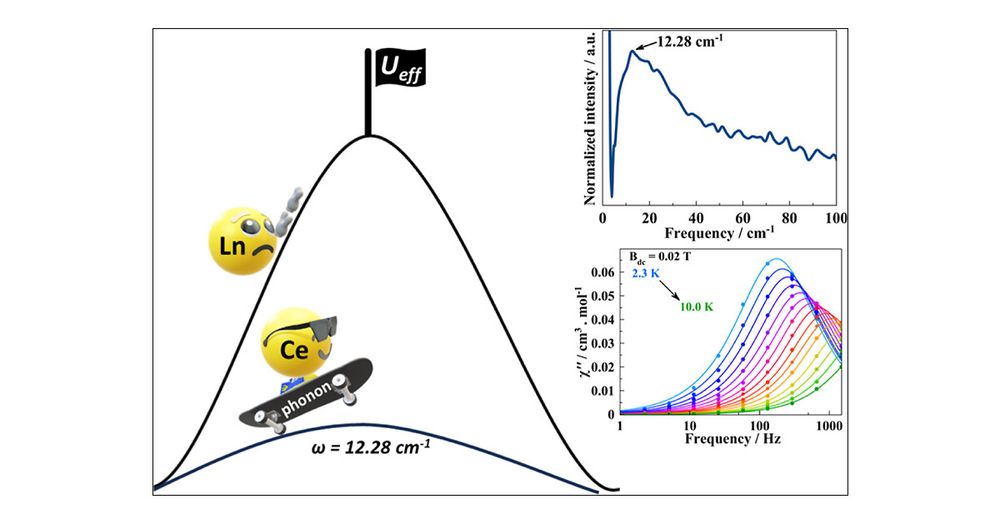
Monocrystal day at #ALBAsynchrotron using the XALOC line. @in2ub.bsky.social
13.03.2025 08:41 — 👍 1 🔁 0 💬 0 📌 0
#ResearchIN2UB | #MagnetIN2UB
04.03.2025 11:51 — 👍 1 🔁 1 💬 0 📌 0
Thanks!☺️
21.02.2025 07:26 — 👍 0 🔁 0 💬 0 📌 0

Cerium-Based Metal–Organic Frameworks: Unveiling the Role of Terahertz Vibrations in the Spin Relaxation Dynamics
The reaction between two equivalents of the Schiff base ligands N,N′-bis(3-methoxysalicylidene)ethylenediamine (H2L1) or enantiopure N,N′-bis(3-methoxysalicylidene)cyclohexane-1,2-diamine (H2L2) with one equivalent of Ce(NO3)3·6H2O in the presence of a bulky counteranion leads to the formation of chiral metal–organic frameworks (MOFs) whose channels encapsulate the counteranion, leading to the formation of compounds with the structural formulas {[Ce(NO3)2(L1)2]X·H2O}n, where X = ClO4– (1), PF6– (2), or BF4– (3), and {[Ce(NO3)2(L2)2]X·CH3CN}n, where X = ClO4– (4), PF6– (5), or BF4– (6), as well as the isostructural reference compound {Nd(NO3)2(L1)2]BF4·CH3CN}n (3Nd). A combination of static and dynamic magnetic measurements demonstrates the good isolation of the CeIII centers and a field-induced slow relaxation of the magnetization. Correlations between the temperature and field-dependent magnetic relaxation data and ultralow-frequency Raman spectroscopy reveal the presence of a vibronic barrier driving magnetic relaxation. Theoretical calculations have been performed to elucidate the nonparticipation of the electronic excited states in the main relaxation processes.
Check out our last publication in Inorganic Chemistry about the role of THz vibrations in spin dynamics @acs.org @in2ub.bsky.social pubs.acs.org/doi/10.1021/...
21.02.2025 05:41 — 👍 2 🔁 0 💬 1 📌 1
As a division of @acs.org, ACS Publications is proud to publish the most trusted, most cited, and most read collection of journals in the chemical and related sciences.
Explore ACS Publications: pubs.acs.org
Tenure Track Assistant Professor (RTD-B) in Chemistry at the University of Florence. Molecular magnetism, computational chemistry, and less exciting stuff.
Broom McIntyre Fellow in School of Chemistry at the University of St Andrews; key research interests include low coordinate f-element complexes and main group chemistry
Liebig Fellow Group Leader at Ruhr University Bochum, Laboratory for Medicinal Inorganic Chemistry
https://www.kargesgroup.ruhr-uni-bochum.de/
Organic synthesis | Methodology | Catalysis | C–H functionalization | Arynes ⬢ Mechanochemistry ⛬ Dept. of Chemistry – BMC, Uppsala University, Sweden.
Heisenberg-Professor in inorganic chemistry at Leipzig University (Germany). Less is more: low-coordinate and low-valent chemistry of 3d metals.
Col·lectiu de docents de matèries científiques indignats per com es maltracta la ciència a l'educació i en conseqüència, a la societat.
Prof. David Mills and his synthetic inorganic chemistry research group at the Department of Chemistry of UoM. Posts by DM.
Australian physical inorganic chemist 🐨, chorister 🎶, board game enthusiast⏳, love the beach 🌊, walking 🌳, travel 🌏, books 📖 and tv 📺
Adelaide, Melbourne, Manchester and Florence are all home
Filial de l'Institut d'Estudis Catalans
Institut de Ciència de Materials de Barcelona (ICMAB, CSIC). Centre de recerca en ciència de materials. Ubicats al Campus de la UAB. Excel·lència Severo Ochoa des de 2016.
Supramolecular chemist at UNSW Sydney, Australia. #ozchem #ChemSky
https://bevesgroup.wordpress.com
Official home for the #Chemistry community #RealTimeChem (part of #ChemSky). Connecting chemists (on the old place since 2012. Curated by @doctorgalactic.bsky.social.
Join in by sharing chemistry using #RealTimeChem.
https://cen.acs.org/
Sharing the world of #chemistry: News🗞 Research⚗️ Infographics #PeriodicGraphics ℹ Pictures #CENChemPics 📷 Comics #SketchChemistry 🗯 #FluorescenceFriday ❇️
Royal Society University Research Fellow. ☢️ Actinides, 🌈 f-elements, 🥦 herbivore, 🐈 cats, ⚗️ chemistry. 🏳️🌈🇪🇺 Views mine. He/him.
A reviews journal from Cell Press. We publish thoughtfully designed Review, Opinion, and short articles covering the breadth of chemistry in an accessible, educational manner.
https://www.cell.com/trends/chemistry/home
A journal that covers all aspects of nanoscale science and technology.
🌐 https://www.nature.com/nnano/
📍Berlin, London and Shanghai.
Part of Nature Portfolio.
Synthetic organic chemistry at the University of Groningen and the Stratingh Institute for Chemistry | #ChemNobel 2016 | Making smart molecules & forging stereocenters since '88
https://benferinga.com
#WomenInSTEM
Phthalocyanines & co
Photodynamic Therapy & Molecular Materials & Nanomedicine
Associate editor JPP & RSC Advances
Acıbadem Univ.
French in Türkiye since 2005
FRSC



